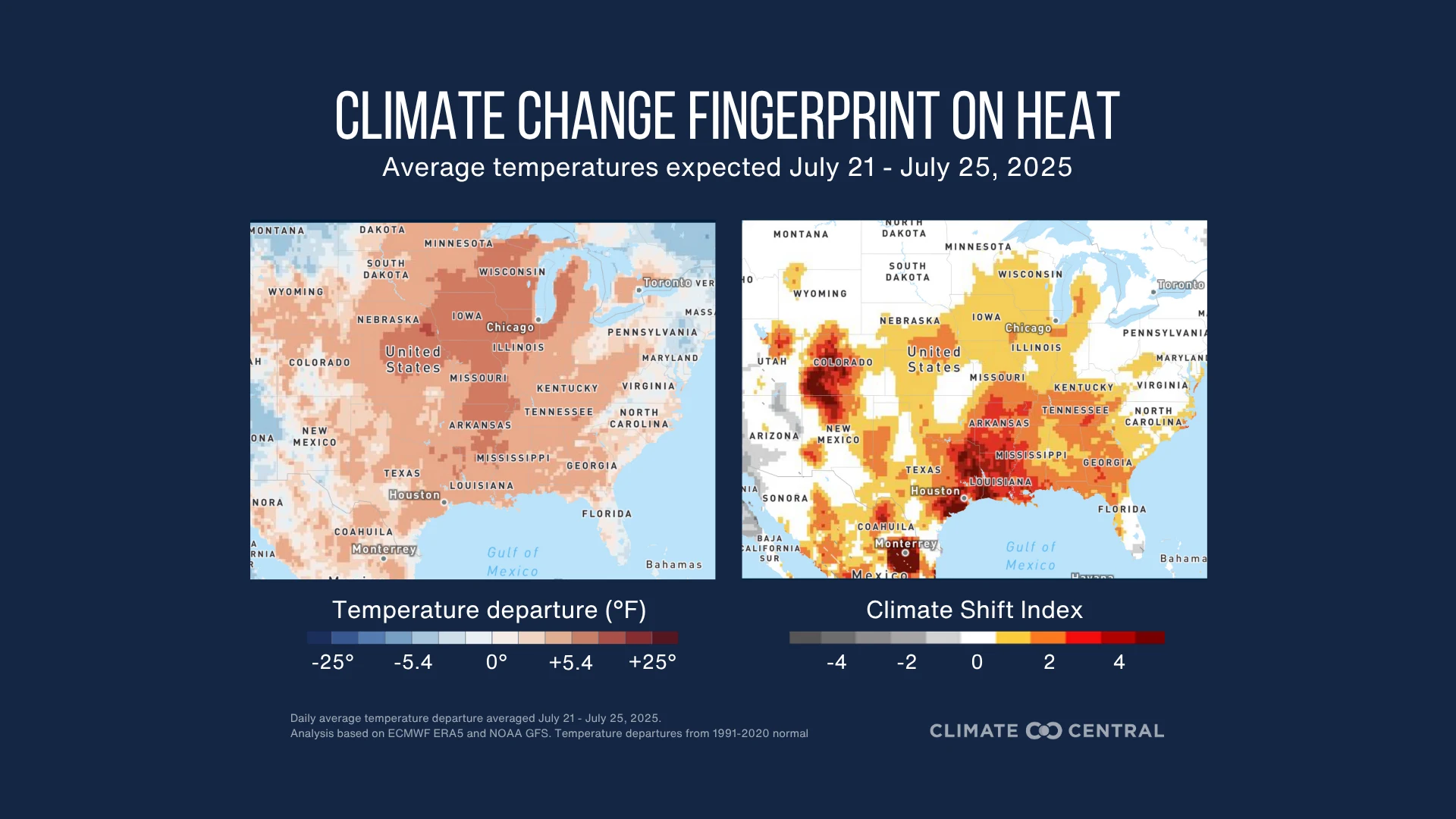Climate Shift Index Alert•July 21, 2025
Climate change intensifies midsummer U.S. heatwave for millions
July 21, 2025
A prolonged stretch of unusually hot, midsummer heat and humidity will grip a large portion of the United States from July 21 to 25. What began across the Southeast over the weekend is forecast to expand into the mid-South early in the week, then expand into the Midwest by mid-to-late week.
A Climate Central analysis finds that human-caused climate change made this excessive heat at least three times more likely for nearly 160 million people, nearly half of the U.S. population.
Note: This event may continue beyond July 25. Use the Global Climate Shift Index map to stay updated on heat in your region.

How unusual is the forecasted heat?
Triple-digit highs are forecast for multiple days in parts of Arkansas, Kansas, Missouri, northern Louisiana, Oklahoma, and Texas.
Forecast highs in the mid-to-upper 90s spread into the lower Midwest by midweek, with similar temperatures possible in the Northeast by late week.
High humidity will intensify the heat, especially in the Central Plains, Midwest, and Mississippi and Ohio valleys, where heat index values could reach between 105°F to 110°F.
Unusually warm overnight lows in the mid-70s to low 80s — as much as 5°F to 15°F above average for this time of the year — are forecast to potentially break record high minimums (the warmest low temperatures on record) in states like Alabama, Arkansas, Florida, Georgia, Kentucky, Louisiana, Missouri, South Carolina, and Tennessee.
A strong area of high pressure, known as a heat dome, will anchor this weather pattern, funneling hot, humid air north and northeast throughout the week.
How has climate change influenced this heat?
Climate Shift Index (CSI) levels of 5 — the highest possible — are forecast across wide swaths of the country, from Salt Lake City and Santa Fe to Tallahassee and Montgomery, meaning human-caused climate change made this extreme heat at least five times more likely. This signals an exceptional climate-influenced event.
Over the full period, nearly 160 million people across the interior United States — nearly half of the population — will experience at least one day with a CSI of 3 or higher, indicating a strong influence from climate change.
What do experts say?
Dr. Kristina Dahl, VP of Science at Climate Central, said:
“This is not your grandmother’s heat wave. Yes, July is usually a hot month, but climate change is making this heat wave significantly hotter — and therefore more dangerous — than heat waves of the past.”
To request an interview with a Climate Central scientist, please contact Abbie Veitch at aveitch@climatecentral.org.
How do we know climate change is influencing this heat?
The Climate Shift Index uses peer-reviewed methodology and real-time data to estimate how climate change has increased the likelihood of a particular daily temperature.
Reporting resources
For quick facts about extreme heat in the U.S. → Extreme Heat Toolkit
For accessing this data in MAX or Baron Weather Systems → Climate Shift Index in KML
For an in-depth guide about how to report on attribution science and extreme weather types → World Weather Attribution’s reporting guide
For the latest research-backed messaging to use while reporting on climate change → Potential Energy’s Guide to Reporting on Unnatural Disasters
